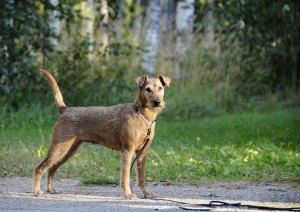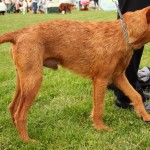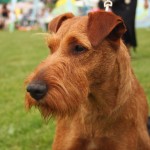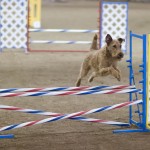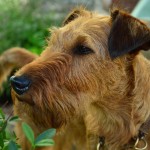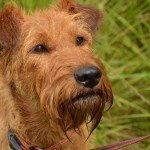Irish Terrier
Traits:
Weight:27 pounds (male), 25 pounds (female)
Height:18 inches
Coat:Medium length, dense, wiry, double
Color:Red, red wheaten, wheaten
Life span:13-15 years
Classification:
AKC - American Kennel Club: Terrier
UKC - United Kennel Club: Terrier
TKC - The Kennel Club: Terrier
NZKC - New Zealand Kennel Club: Terrier
FCI - International: 3 - Terriers, 3.1 - Large and Medium Sized Terriers
The Irish Terrier is known for its intelligence and love of adventure. They make ideal family dogs, but they can also be a challenge to train if you don’t have the patience for them. They are independent dogs that want to make their own choices, and they will test you to see how much they can trust you.
This breed needs regular daily exercise to stay happy and healthy. Irish Terriers are very social, which means they tend to thrive when they live with another dog or two that share the same interests as them. Getting enough socialization as a puppy is essential for this breed’s development, but even just exposure to new people and environments early on will help them become more confident around strangers and fearful situations as they grow older.
History of the Irish Terrier
The Irish Terrier was developed in Ireland as a hunting dog, and they have been bred for that specific purpose ever since. Irish Terriers were often shown with Irish Setters, and they were also used to hunt with large packs of hounds, similar to European Staghounds. The dogs that were used for this purpose were the largest of the breed and had the strongest hunting instincts.
Today, Irish Terriers are still used for hunting, though they are also used for a variety of tasks such as detection, tracking, protection, and narcotics detection. Irish Terriers can be very affectionate and loving dogs, but they also have very strong hunting instincts, and some owners report that their dogs are expert hunters.
Due to their hunting history they are not recommended for apartment or condo owners. These dogs need a large backyard or the ability to go on walks outside all the time. Irish Terriers are a short-legged breed that should not be expected to run long distances.
Appearance
Irish Terriers are medium-sized dogs, and they can range in size from 13 to 18 pounds as adults. The coat is typically short and smooth, with a single color being preferred.
The typical coat colors are solid black, gray, red, or red and white, but Irish Terriers with more specific colors such as blue or pink are also seen.
Irish Terriers come in one of two coat lengths: standard or toy. The standard coat is longer and plummier, while the toy coat is shorter and sparser.
Both coat types are easy to care for and don’t require a lot of grooming. Coat types are favored for different purposes, though. The standard coat is preferred for hunting and is typically less common than the toy coat, which is preferred for showing.
Personality
Irish Terriers are intelligent dogs that love to learn new skills and challenges. They can be stubborn and independent, but they also need a confident owner who is willing to enforce rules and boundaries.
Irish Terriers are very social, so they need regular exposure to different people, dogs, and environments. If they don’t get this socialization as puppies, they can become anxious in crowds later in life and may try to bite if they feel threatened. This breed is very energetic, so they need daily exercise to stay happy and healthy.
Irish Terriers are not a good breed for first-time dog owners. They need a confident owner who is willing to enforce rules and boundaries and be firm but kind to them. If left alone for too long, these dogs can be destructive, so they’ll also benefit from a stay at a doggy daycare.
Health Problems
Irish Terriers are a very healthy breed overall, but they are susceptible to a few health issues. Hip dysplasia is a common inherited health problem that is caused by improper growth of the hip joints. The condition can be inherited through the breed’s heritability, or it can be caused by improper breeding practices.
Irish Terriers are prone to developing epilepsy and canine cognitive dysfunction, which are both incurable diseases. The breed is also prone to eye problems such as dry eye, cataracts, and progressive retinal atrophy. Irish Terriers are a short-legged breed, so they are at a higher risk for developing arthritis and other bone disorders.
Training Tips
Irish Terriers are very smart dogs that learn easily, but they need consistent leadership and firm rules to keep them from getting out of control. They are very active dogs, so they need daily exercise to stay happy and healthy.
This dog breed is very territorial, so they should not be trusted with small pets without supervision. They are also quick to chew, so owners should keep chew toys and bones out of their reach. Irish Terriers are also known for digging, so they should be taught to wait at heel before being let off the leash.
Despite their intelligence, these dogs can be difficult to train.
Conclusion
The Irish Terrier is a smart, active breed that is happiest when living a full life as a hunter and protector. They are active dogs that need a lot of daily exercise to stay happy and healthy, and they are prone to several health issues. These dogs need firm leadership and consistent rules to stay out of trouble.
Irish Terrier Photo Gallery
You can click on the gallery images below to view them full sized (most are in wallpaper resolution!).

















